
When you walk into a wet market in Chinatown or an Asian grocery store, you’ll usually see arrays of fresh green vegetables piled up in the produce section. They look very different from the “regular produce” you see in Whole Foods or Trader Joe’s. And the veggie vendors usually mark them with obscure names that are phonetically translated from their Chinese names. Or even worse, just in Chinese characters, or with no name tag at all.
I want to share this basic guide to Chinese greens with you today. So it helps you to navigate and purchase common Chinese leafy greens, learn the basic cooking techniques, and open more doors to creating nutritious meals that taste good.
Understand
Chinese greens (绿菜, lǜ cài) are fast-growing vegetables that comprise the plant’s fresh green leaves, tender stems, and/or the plant’s fruit or flower. They are widely used in Asian cuisine to bulk up stir-fries, soups, and other dishes. Chinese greens are valued for their high vitamin, fiber, and iron content.
Chinese cuisine uses an abundance of its own green vegetables to bring excellent nutrients, taste, and texture to a huge number of dishes. On a regular Chinese family dinner table, you can usually spot a few dishes using various green vegetables, along with a protein dish, a soup, and rice (sometimes noodles or dumplings).

There are more than 30 species of leafy green vegetables cultivated in China. In this list, I have also included some non-leafy greens that are commonly found in Chinese cuisine.
Naturally, different types of greens are grown depending on the climate and soil of the region. In the colder northern and north-eastern parts of China, there is less sunlight. Greens such as napa cabbage, spinach, celery, cilantro, bok choy, chives, and lettuce are widely grown there. These plants are important during the winter months as a source of vitamins and minerals. In the more temperate climes of the south, Malabar spinach, edible amaranth, and water spinach are pretty common.
An Introduction to Chinese Greens
There are so many different varieties of edible greens available, it would be impossible to list them all. But to break it down, these are the most common ones used in Chinese cuisine, with some example recipes.
You’ll notice that some of the veggies do not include a recipe yet. I’m still working on this list and will update the post with more information and recipes in the future. Do bookmark the page and come back to check out the updates!
Round leaf spinach (圆叶菠菜, yuán yè bō cài)
Reaching a length of about 20cm, its leaves are tender and sweet. Sometimes known as flat-leaf spinach, it’s a common leafy green in the West, too.
I find that the round leaf spinach in Chinese markets has a longer and thicker stem than the regular spinach I see in the US. I enjoy using it in braised dishes because it withstands the high heat better and doesn’t turn mushy too fast. The spinach batch in the regular market works just as well. But do note, the packaged baby spinach (usually used in salads) requires way less cooking time.
Recipes using round leaf spinach
Garlic Spinach in Chicken Broth – It’s very common to cook tender leafy greens in a concentrated broth (高汤), which can be made with chicken and/or pork bones and is boiled down to a rich reduction. Simply saute some aromatics (usually garlic or ginger) with oil, then saute the veggies and splash them with the rich broth, and you will have a plate of tender veggies that are very flavorful.
This cooking method is commonly used with pea shoots, baby cabbage, water spinach, and amaranth in China. I also enjoy using it to cook kale.
Chinese Spinach and Peanut Salad – Another way to enjoy spinach. The spinach is blanched and served with a savory sauce with nuts. It’s a cold appetizer that goes well with dim sum, congee, and noodles.
Cilantro (香菜, xiāngcài)
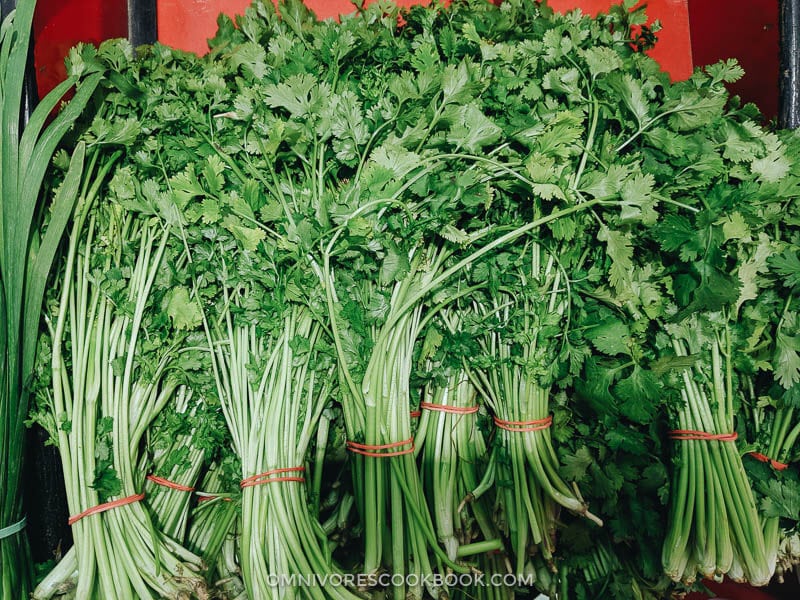
Also known as coriander or, confusingly, Chinese parsley, it has a soft texture and strong fragrance that some people are repelled by.
It’s common in Chinese cuisine to finish up a dish by adding chopped cilantro at the end of cooking to add a citrusy note. For example, on hot and sour soup and wonton soup.
It’s also commonly used in cold dishes to add fragrance and cut the grease of meat. For example, Bang Bang Chicken, Fu Qi Fei Pian (Sichuan Sliced Beef in Chili Sauce, 夫妻肺片), and Chinese Pork Belly Bun (Rou Jia Mo, 肉夹馍).
Water spinach (空心菜, kōng xīn cài, Ong Choi)
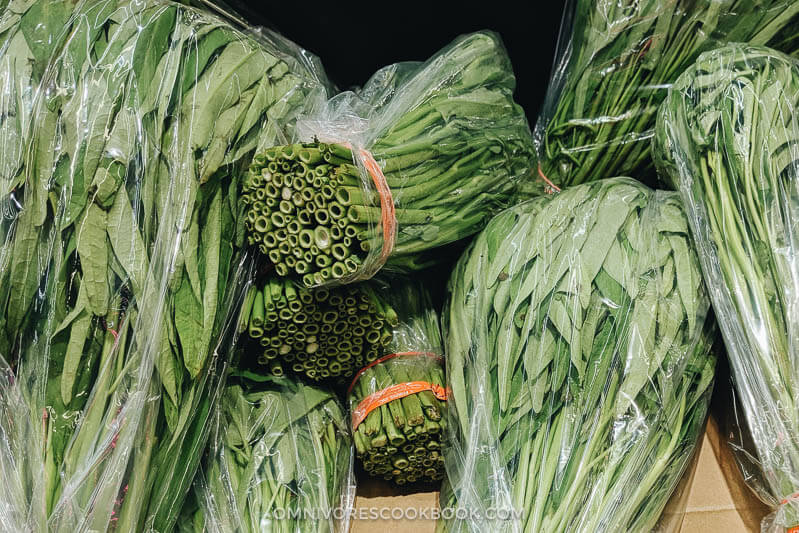
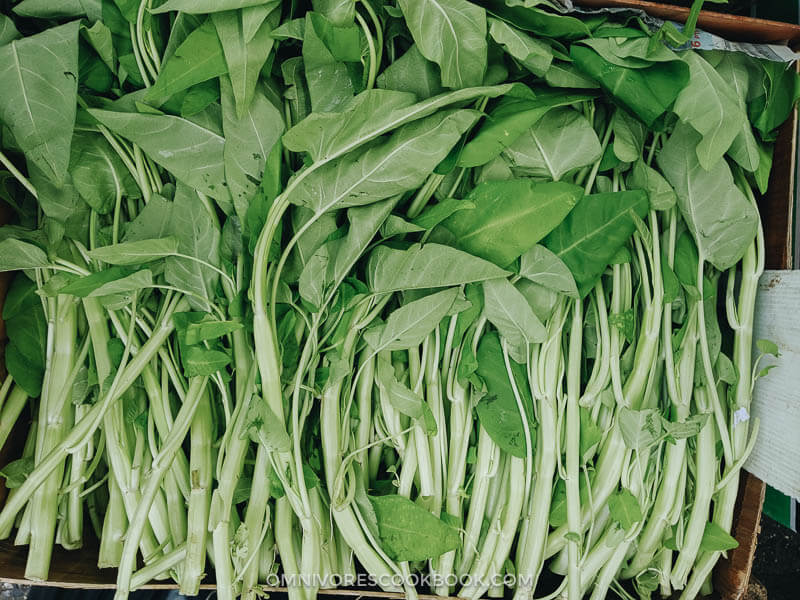
Or ‘empty-hearted’ spinach because of its round, hollow stems. It has slender and pointed leaves. It is especially popular in Southern Chinese and Southeast Asian cuisine, where it is known as ‘kang kung’ and “ong choi”. Once chopped and cooked, water spinach has a tender texture and very mild taste. Although you can simply stir fry water spinach with aromatics and a pinch of salt, it’s popular to cook it with a stronger sauce because the veggie picks up whatever flavor you add to it.
To learn more about how to prep and cook water spinach, check out Stir-Fried Water Spinach – Two Ways.
Malabar spinach (木耳菜, mù’ěr cài)
Meaty stems with coarser and shinier leaves than round leaf spinach, but with a similar taste. The whole plant can be boiled or fried.
Napa cabbage (大白菜, dà bái cài)
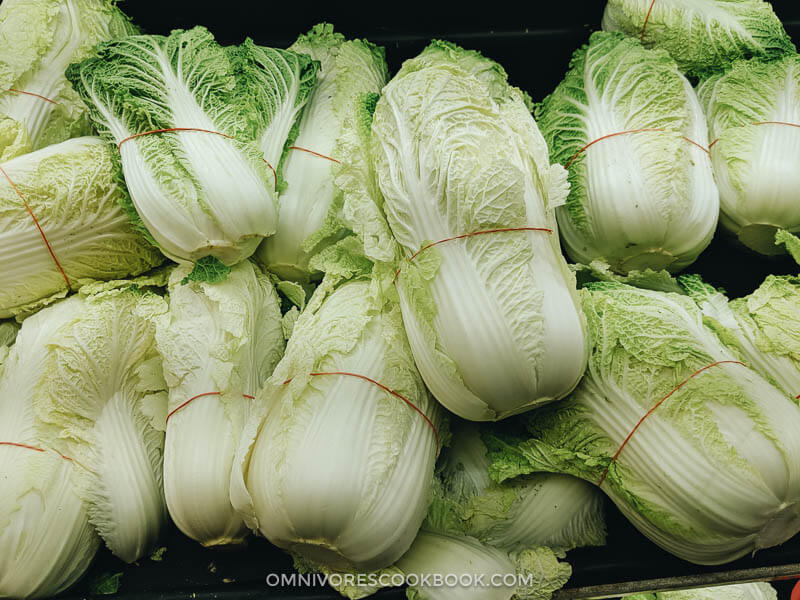
This is THE famous Chinese cabbage. I really think this is China’s favorite – hence the cute name ‘big white vegetable’. In northern China, it’s a staple in winter since it’s one of the few vegetables that grow in cold weather. In Beijing, you’ll see piles of them ready to be pickled in jars to keep as a source of nutrients in the winter, almost like sauerkraut.
I consider napa cabbage a great staple to have at home, because it lasts very long in the fridge if uncut and unwashed, from 2 to 3 weeks. It works perfectly in braised dishes, soups, and stews. The stem and leaves turn very tender and taste sweet once cooked. They also soak up sauce very well. Back in China, my mom usually uses some leftover stewed meat and sauce to braise napa cabbage and glass noodles. Oh my! It makes this veggie taste heavenly.
Recipes using napa cabbage
- Napa Cabbage Stir Fry with Vinegar Sauce (醋溜白菜)
- Chinese Napa Cabbage with Glass Noodles
- Napa Cabbage Soup with Meatballs
- Mom’s Best Pork Dumplings with Cabbage
- Vegetarian Hot and Sour Soup
Baby napa cabbage (娃娃菜, wáwá cài)
Basically a mini version of the above! (Wáwá means child’s doll). Baby napa cabbage is so much smaller than the regular napa cabbage, usually 5 to 6 inches (15 cm) in length. The leaves are thinner and tenderer as a result. It looks quite like endive.
Although you can replace the regular napa cabbage with baby napa cabbage in most of the recipes, it is often cooked halved or quartered for a stunning appearance.
Baby bok choy (上海青, Shànghǎi qīng)
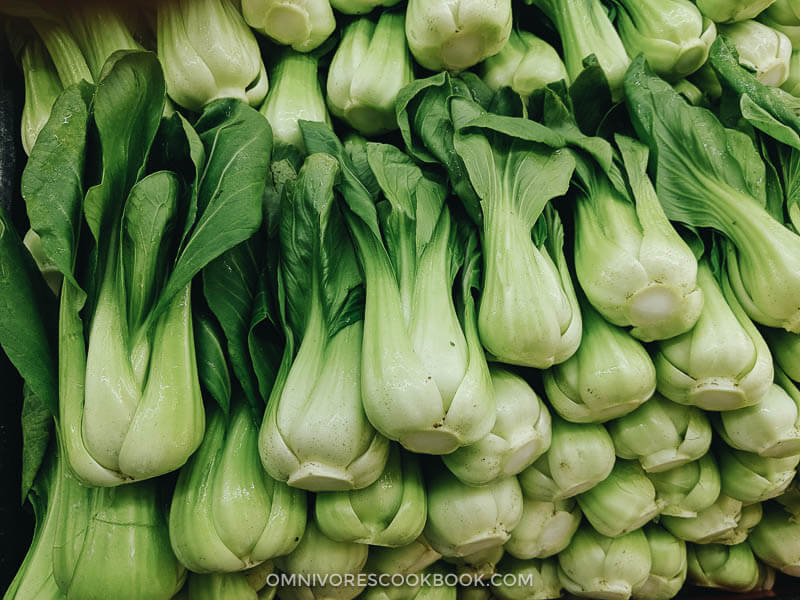
Baby bok choy, or Shanghai bok choy, is a very popular and widely available Asian green in the US. It has mild-tasting spoon-shaped leaves that are lighter green and stems that are jade-green. It is used in Chinese cuisine in many different ways. For example, making stir-fries to enjoy the vegetable by itself, topping them on noodle soup to make your bowl more colorful, or to add a touch of texture and nutrition to a protein dish.
Recipes using baby bok choy
- 4-Ingredient Baby Boky Choy Stir Fry
- Baby bok choy with crispy tofu
- Blanched baby bok choy with garlic sauce
- Stir Fried Baby Bok Choy with Gluten Balls (油菜炒面筋)
- Vegetarian Chow Mein (素菜炒面)
Dwarf bok choy (奶油白菜, nǎi yóu bái cài)
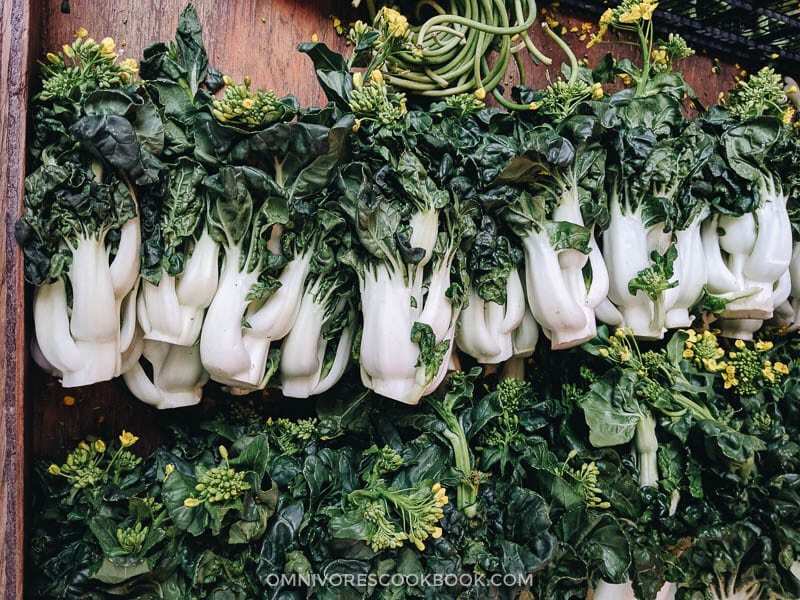
If you’ve never seen a vegetable and thought “that’s adorable!”, you have clearly never seen dwarf bok choy. Its frilly little leaves are the cutest thing. It’s picked at two inches tall and can be used the same as traditional bok choy, in salads and stir-fries.
Chinese broccoli (芥兰, jiè làn, Gai Lan)
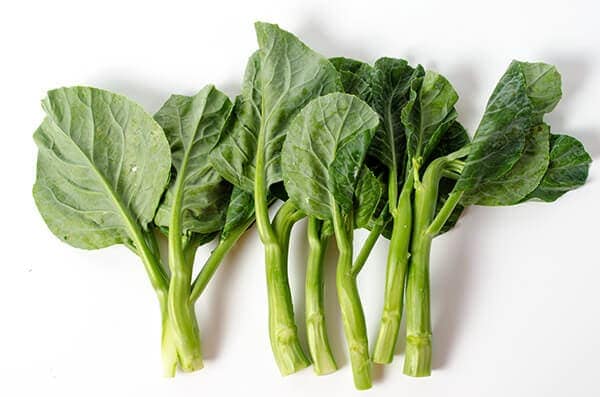
Chinese broccoli is commonly transliterated from the Cantonese as gai lan. Unlike how we picture broccoli, it is a leaf vegetable with big, thick, flat leaves, fat stems and sometimes very small flower heads. It is one of the most popular and widely used leafy vegetables in Chinese cuisine. At most Cantonese dim sum restaurants, you will see gai lan on the menu, usually cooked with a very simple sauce or stir-fried with aromatics.
Recipes using Chinese broccoli
Choy Sum (菜心, 油菜心, cài xīn)
A bit like Chinese broccoli but sweeter, choy sum (Chinese cabbage) has a similar crisp stem texture to bok choy and requires very minimal cooking time. You can enjoy it with some aromatics and a drizzle of soy sauce (see this easy recipe).
Little bok choy (小白菜, xiǎo bái cài)
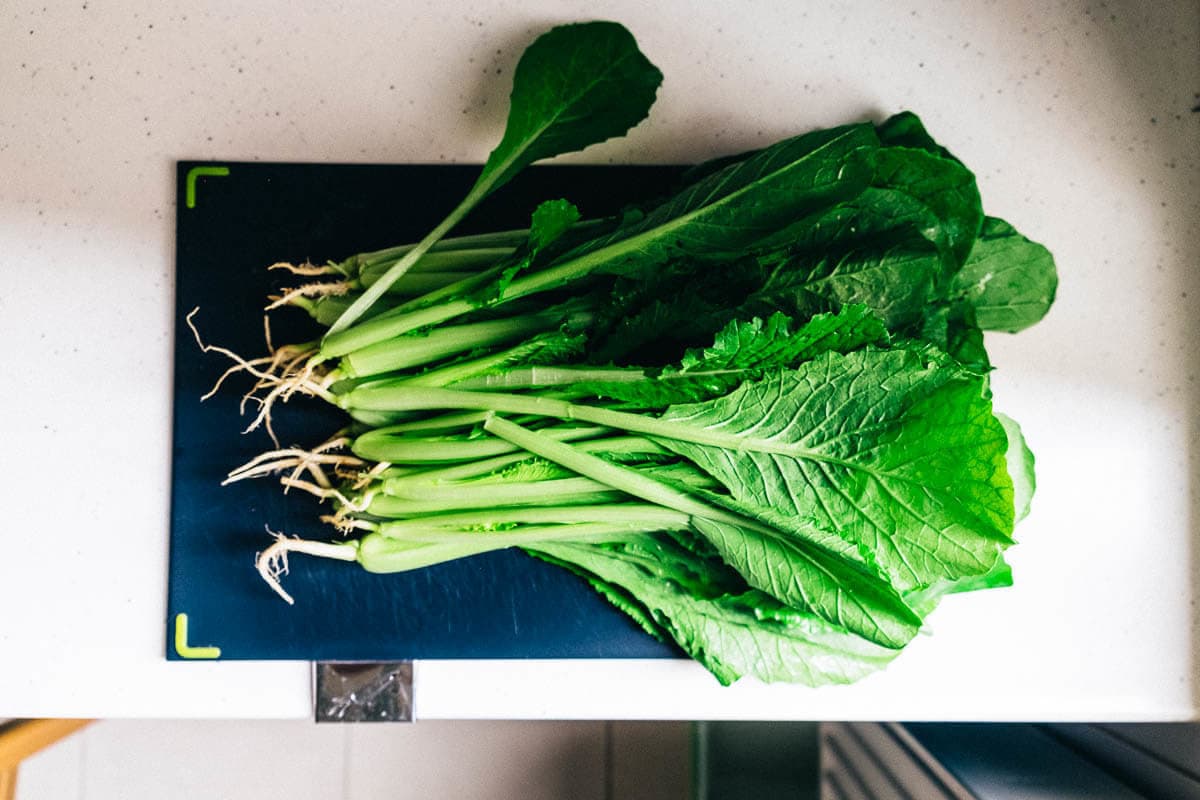
Little bok choy, unlike its sister big napa cabbage, is a popular Chinese green that is less known outside of Asia. It looks a bit like Chinese broccoli (gai lan) and choy sum, but has a straight stalk, flat leaves, and sometimes tiny flower buds. The stalk is crisper, more like the texture of bok choy, and slender. It has a mild grassy flavor. Due to its high water content, little bok choy will lose a lot of liquid during cooking and turn to a tender texture with just a hint of crispiness once cooked.
Check out my mom’s little bok choy recipe to learn how to prepare and cook with little bok choy.
Pea Shoots (豆苗, dòu miáo)
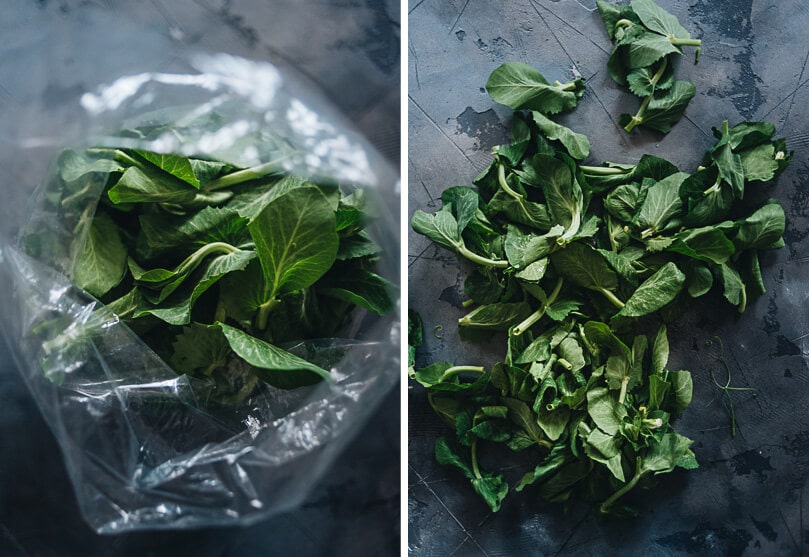
A very popular and delicious green that is usually served in Sichuan cuisine. Unlike the well-known rich spicy Sichuan dishes, the pea shoots are cooked with aromatics and a splash of Shaoxing wine. Once cooked, the pea shoots are very tender and they absorb flavor well.
My mom always reminds me to try to find pea shoots with bigger, fatter stems, because the younger, smaller pea shoots have a tougher texture. Check out this Stir-Fried Pea Shoots with Garlic to make restaurant-style pea shoots.
Chinese celery (芹菜, qín cài)
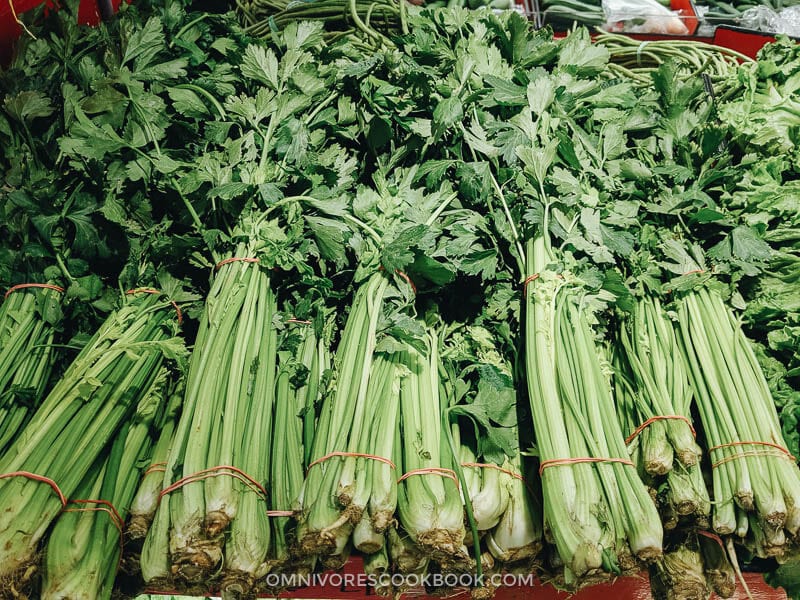
Its stems are curved into round, hollow stalks that are thinner than Western celery stems. Also, unlike Western celery, the Chinese variety is not so bitter and the leaves are sometimes eaten as well. For winning authenticity, use your Chinese celery in a classic Ground Beef Stir Fry.
Celtuce (莴笋, wō sǔn)

Celtuce is a very popular vegetable in China. The leaves of celtuce are really tender and a lot like bibb lettuce. It has a crispy stem and is moist and mildly flavored. I’d say it is most like a cross between cucumber, asparagus, and bamboo shoots. Both the stem and the leaves are edible and are fantastic eaten raw. And you can also cook with both parts in stir fries and soups with light and simple seasonings. If you find them at farmer’s market, they might recommend to replace lettuce with celtuce, but in reality, celtuce tastes so much better and flavorful than lettuce.
Celtuce can look very different depending on when it is harvested. You can see in the pictures below. The celtuce stem on the right is the type you’ll usually see in Asian markets (also the type we’re familiar with in China). The stems are long, about 10” (30 cm), and thick. Sometimes they come with the leaves attached. More often than not, the leaves are sold separately either as celtuce leaves, or You Mai Cai (油麦菜). Celtuce stems are more suitable for stir fries.
At the farmer’s market, I saw some very young celtuce that was just gorgeous (picture on the right). The stem is short and thin, with narrower, tenderer leaves. These usually come in small batches. They are more delicate and is more suitable for salads and gentle saute.
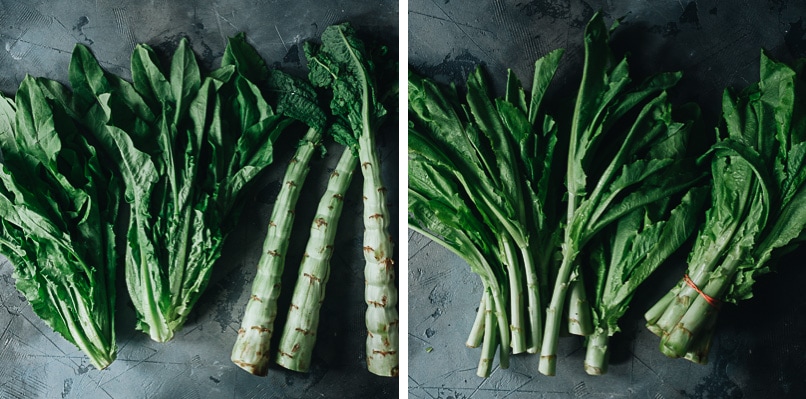
The most popular dishes in China are Celtuce stir fried with eggs, and celtuce leaves salad with sesame sauce. You can also find more info on how to cook with celtuce in both posts.
Luffa/loofah (丝瓜, sī guā)
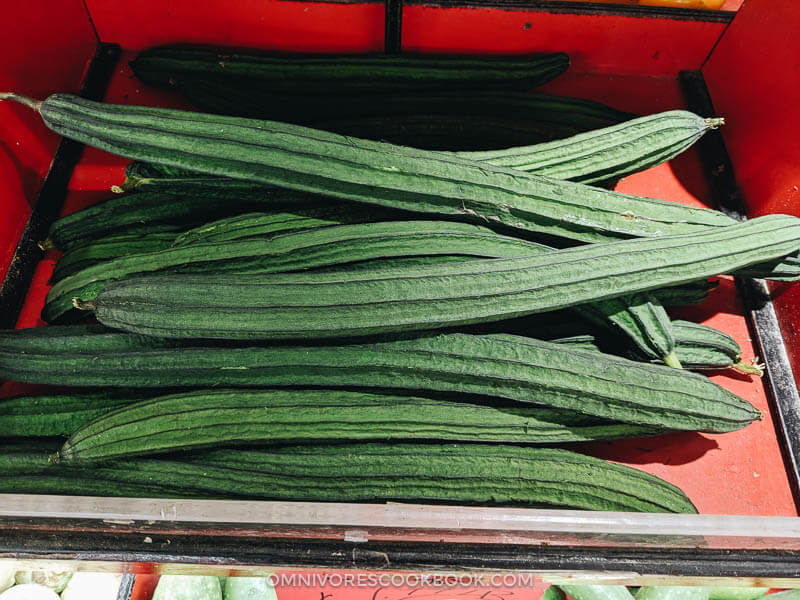
Yes, this plant is the origin of the scrubbing sponge. As a food, it’s popular in China and all over Asia. It looks kind of like a slender zucchini, or ‘thread gourd’ as the Chinese name suggests. It softens and when cooked, with a silky and velvety texture similar to eggplant.
Bitter Melon (苦瓜, kǔ guā)
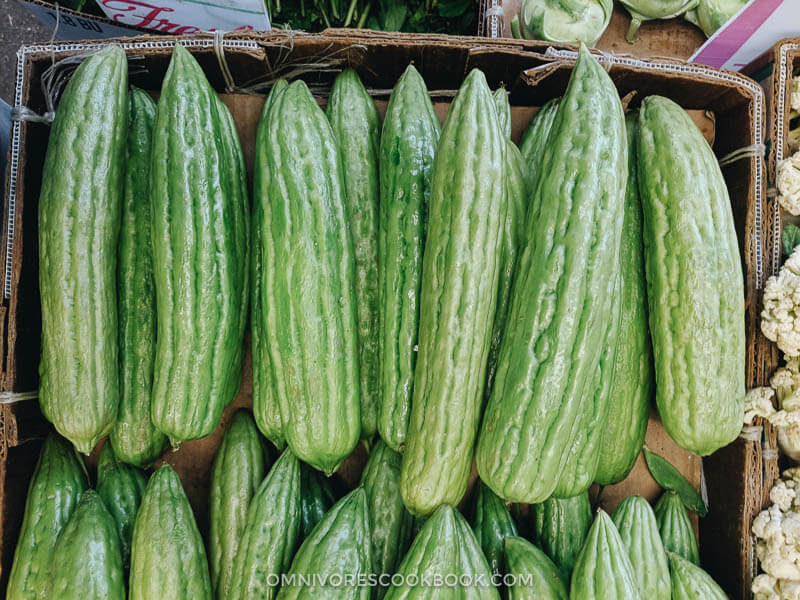
Despite the fact it has a name that doesn’t sound super appetizing, it’s a very popular vegetable in Chinese cuisine. Not only is it quite tasty if you prepare it right. Bitter melon can also help control your blood sugar levels, boost immunity, give you beautiful skin, fight cancer, lower cholesterol, aid in digestion, and much more.
Bitter melon is a bit like if a cucumber and cantaloupe eloped. If it’s harvested before it ripens, then it’s not as bitter. It has uneven skin, spongy seeds, and tender meat. It’s often seeded, sliced, quickly blanched to eliminate the bitterness, and cooked with a strong sauce.
One of my favorites is bitter melon cooked in fermented black bean sauce. Another popular way to enjoy bitter melon is to cook it with beef in a garlic sauce.
Chinese Long Beans (豇豆, jiāng dòu)
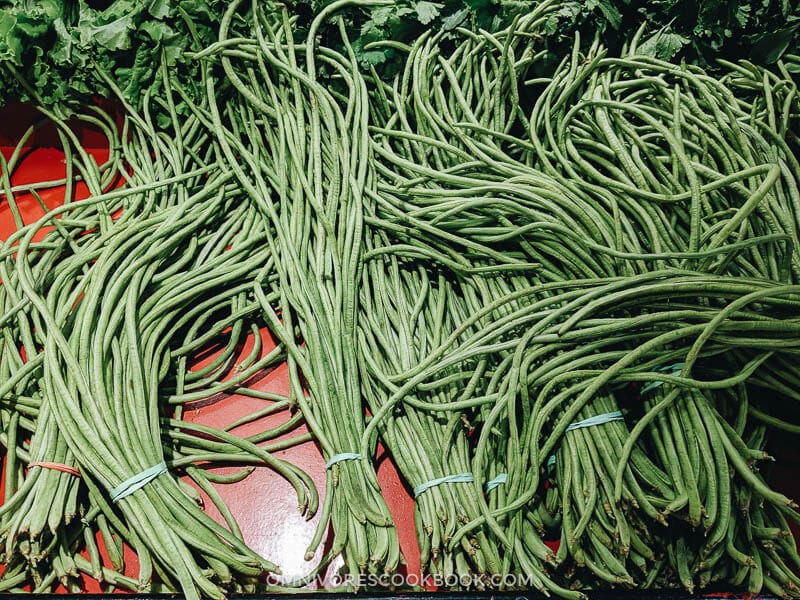
Chinese long beans are also called yardlong beans. They are basically like string beans that are really really long, like the length of your arm. Compared to regular string beans, they have a slightly denser and chewier texture. The edible pod is usually fairly thick and the inner beans are tiny. They’re chopped short in cooking, to make it easier to pick them up with chopsticks or spoons.
Recipes using long beans
In the past, I often used regular green beans to replace long beans, because they are hard to find sometimes. You can easily replace the green beans with long beans by chopping them to the size used in the recipes below.
- Green Beans with Spicy Peanut Sauce
- Stir Fried Green Beans with Ground Pork (豆角炒肉末)
- Sichuan Dry Fried Green Beans (干煸四季豆)
Chinese Chive (韭菜, jiǔ cài)
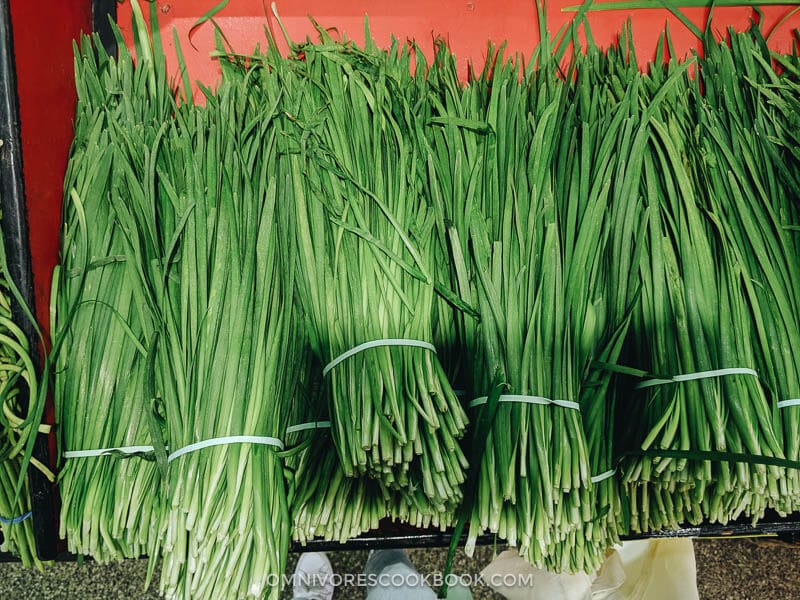
Chinese chives resemble regular chives in shape and color, but with much larger, longer, and meatier leaves. Unlike chives which are usually used as a garnish to finish up a dish, Chinese chives are commonly used as the main ingredient in stir-fried dishes or add to dumpling filling. These delicate emerald straws have a pungent garlicky taste, which gives a kick to whatever dishes they’re used in. It pairs surprisingly well with egg-based dishes. The egg and Chinese chive combo is also a popular dumpling filling, featured in Beijing’s typical street snacks.
Recipes using Chinese chive
- Chinese Chive Pockets (Chinese Chive Dumplings)
- Steamed Pork Buns with Chive (猪肉韭菜包子)
- Yellow Chives and Eggs Stir Fry (I used yellow chive in this recipe, but you can use green chives as well)
Chinese Yellow Chive (韭黄, jiǔ huáng)
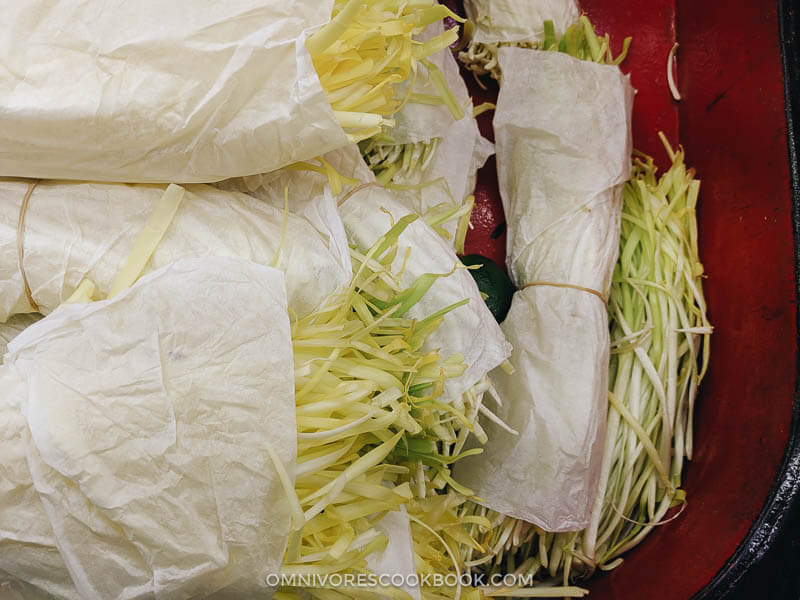
Chinese yellow chives are chives that have been grown in an isolated dark room without exposure to sunlight. Due to the lack of photosynthesis during growth, the chives end up with yellow color and a more delicate texture. Their taste is similar to Chinese chives, only milder. It’s quite common to use Chinese yellow chives to make classic chive and egg stir fry, to create a better mouthfeel.
Garlic Sprouts (蒜苗, suàn miáo)
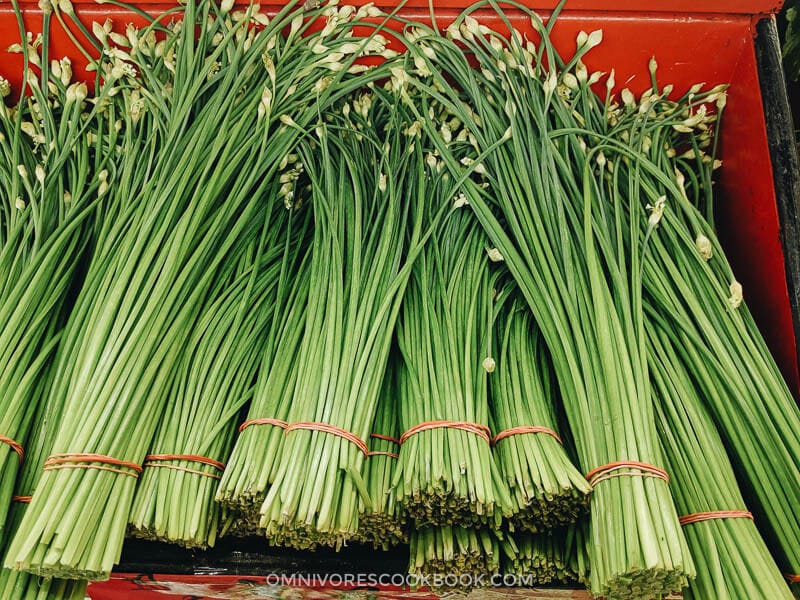
Garlic sprouts are also called 蒜苔 (suan tai) or 青葱 (qing cong). You know when you leave a garlic bulb and it starts growing a green shoot? These are similar in appearance to garlic chives, but slightly thicker, sturdier, and lighter green in color.
They make a more substantial ingredient (such as in the famous Garlic Sprouts with Shredded Pork) rather than being used as a condiment.
Shepherd’s purse (荠菜, jì cài)
I don’t know what shepherds keep their cash in, but I’m not sure it looks this much like a common garden weed! Shepherd’s purse is pretty rare in the US, but if you can find some frozen, wrap the leaves into some steamed pork dumplings or wontons for a truly unique, aromatic taste.
Chinese mustard greens (芥菜, jiè cài)
This strong-flavored variety of greens is naturally acerbic so it’s best not eat them raw on their own. They are usually pickled in plenty of salt and used as a table condiment rather than as a main ingredient, topping blander dishes like congee. Mustard greens are believed to have impressive medicinal properties; you be the judge after trying this Suan Cai Yu (Sichuan Fish with Pickled Mustard Greens).
Amaranth/Red Spinach/Yin Choy (苋菜, xiàn cài)
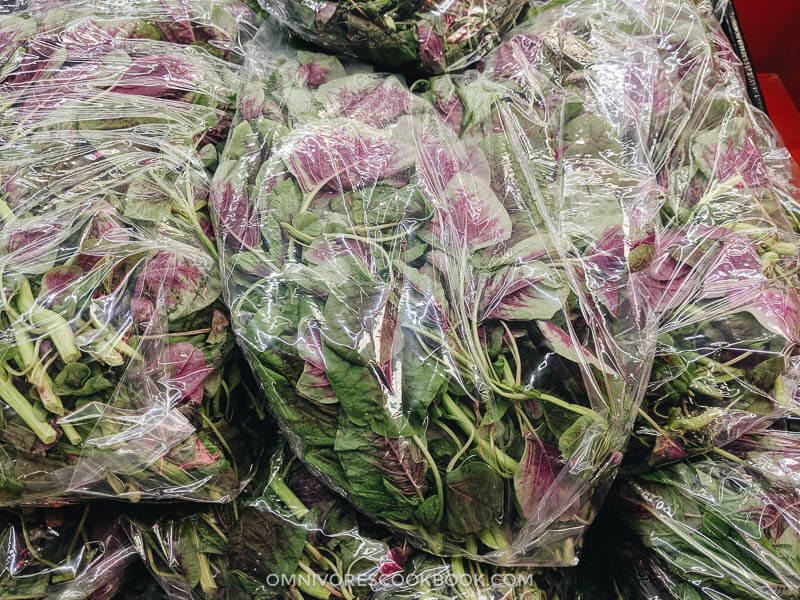
You may know it best as amaranth, but this leafy veg adds a beautiful splash of reddish purple to any dish. The leaves soften and tone down in flavor when cooked, acquiring a rich, smooth and earthy texture
Watercress (西洋菜, xī yáng cài)
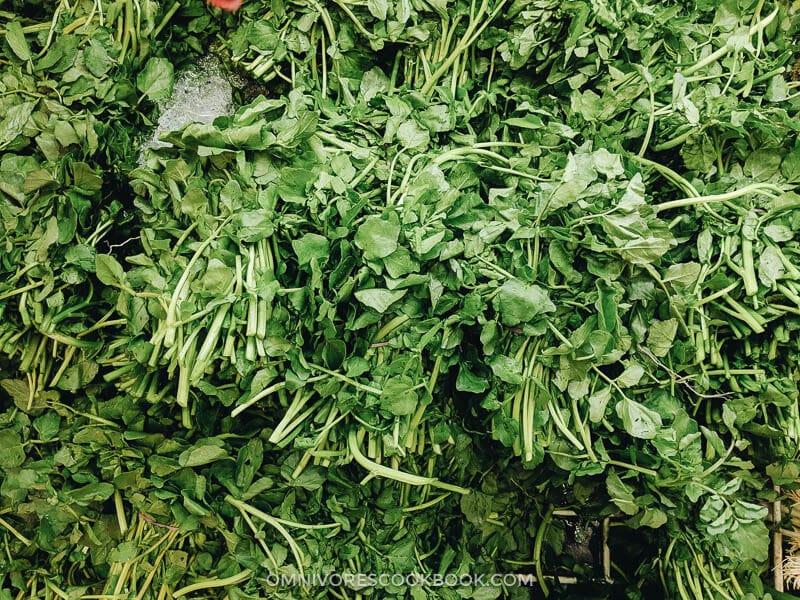
We are pretty familiar with watercress in the West, but have you ever tried it in Chinese cuisine? With its penny-shaped leaves, its delicate texture and flavor when cooked perfectly complement mild salads and hearty soups, like this Watercress and Pork Wonton Soup.
Edible Chrysanthemum (茼蒿, tóng hāo)
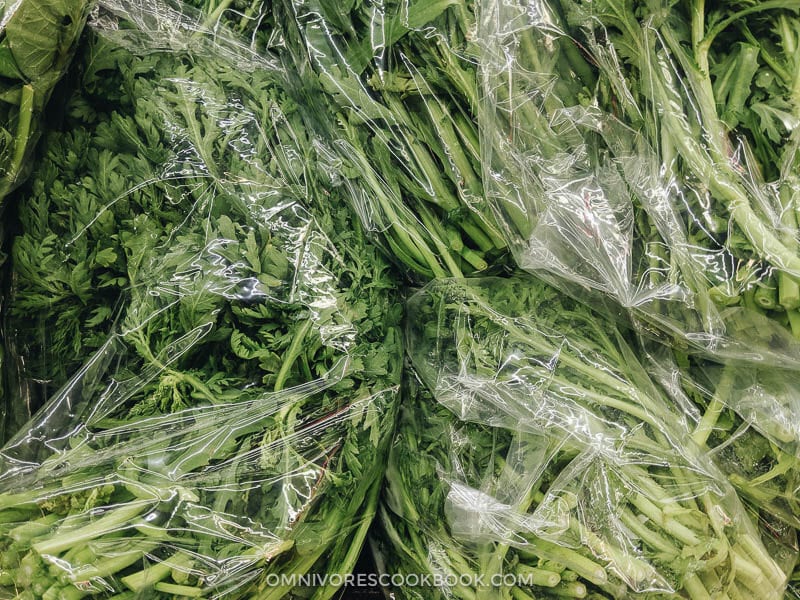
Known as Tong Ho in Cantonese, there are two types of this chrysanthemum. One has larger, rounded leaves while the other has more slender serrated ones, and both have aromatic flavors. Both can be used in stir fries, hot pot or cold side dishes. Try out the traditional Chinese chrysanthemum salad or using it in place of spinach in this classic Peanut Salad.
Sweet Potato/Yam leaves (地瓜苗, dì guā miáo)
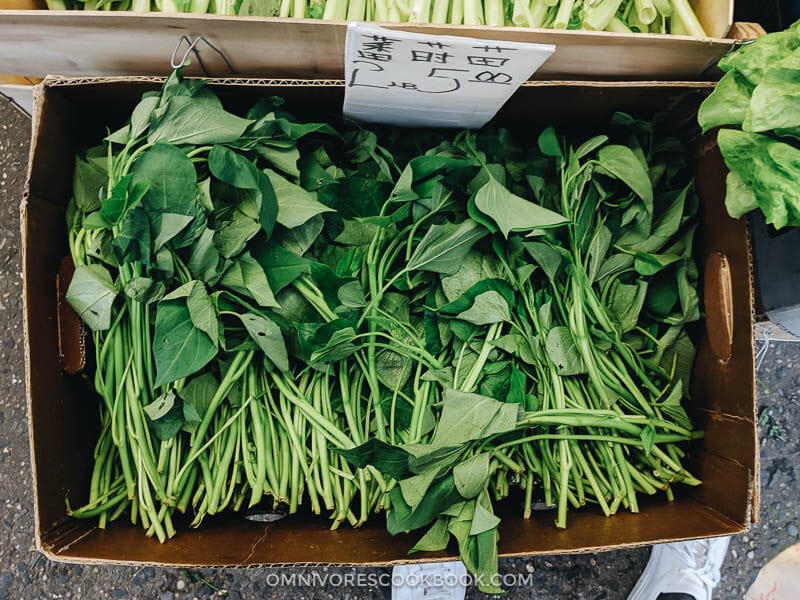
I love that the Chinese word for sweet potato is ‘earth gourd’. And yes, you can eat its leaves! To be honest, it’s not that common for Chinese people to regularly consume these heart-shaped greens, but they are prized for their abundant vitamin content. Just make sure you don’t confuse them with ordinary potato leaves! How about trying them in place of kale in this Shrimp Soup with Tofu?
Use
Greens have been used in cooked and cold dishes for thousands of years in China, being historically more readily available in rural areas than animal products. Alongside rice or noodles, they usually form the base component to most dishes and stir-fries. Although nowadays they are often used to complement meat in restaurants in big cities. Due to concerns about chemicals and bacteria, Chinese greens will almost never be eaten raw, unlike in the US where we often use uncooked vegetables in cold salads.
In preparation, Chinese greens should be washed thoroughly first, have the tough parts removed, and cut. They should be cooked as fresh as possible to get the most benefit from the nutrients, which diminish the longer they are kept.
In China, greens are generally cooked at very high heat for the briefest possible time. The longer you cook these vegetables, the more vitamins and texture will be lost (unless it is in a soup, in which case they diffuse into the broth). Often aromatics and simple seasonings are used in order to maintain the vibrant colors and nutritional qualities.
Buy
As with most of the pantry ingredients on this blog, you can find many varieties of Chinese greens at your local Chinatown or Asian market. Although some will be rarer, or only sold frozen. These days, many mainstream supermarkets or open-air markets that import fresh foreign goods will stock a selection in the fresh produce section. Avoid buying any unfrozen packaged greens as they are less likely to be fresh and will be of much lower quality, reducing the deliciousness of your meals. An exception would be pickled or preserved greens, such as the mustard greens or pickled napa cabbage.
Store
Like with most vegetables, Chinese greens have a very short shelf-life and should ideally be cooked within one to two days of purchase. If you cannot, store them in the fridge in a bag for 3 to 4 days for fragile leafy vegetables such as pea shoots and water spinach. For meatier vegetables such as Chinese broccoli and celtuce, they will keep as long as a week. Napa cabbage is the one with the longest shelf life, often staying good for 2 to 3 weeks unwashed and uncut. The leafy greens will begin to wilt if you don’t cook them soon. And it will require a longer time to prep if you need to sort through the leaves and get rid of the parts that have gone bad.
You should always consume the cooked leafy greens as soon as they’re cooked, for the best taste. Although you can store the cooked greens in an air-tight container for a day or two in the fridge. The veggies will lose their green color and turn dark or brownish when you store them. Meatier veggies can be stored longer in the fridge, but I recommend you consume them as soon as possible. The veggies will lose more nutrients when you store them longer.
You should always avoid freezing green vegetables, whether raw or cooked. Due to the high water content, the veggies will release liquid in the freezer and cause freezer burn.
Can’t find what you’re looking for?
I’m still working on the list at the moment and will update it with more recipes. If you need a recipe using a specific vegetable, leave a comment below to let me know. I’ll try my best to develop the recipe for you.



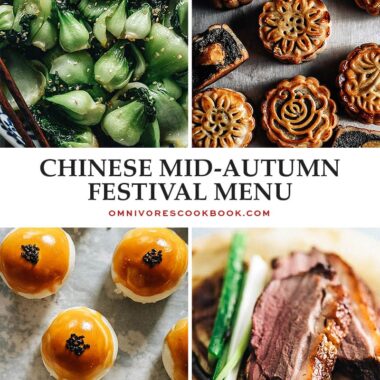
Gardener!
Some of these greens are very easy to grow yourself! Then you can pick & use within minutes!!! Pea shoots (Dwarf Grey sugar pea seeds work great) take only 8-10 days to harvest! (Soak overnight, grow in very shallow soil indoors under lights or by a sunny window). Beka Santoh or Kogane can also be grown indoors or on a deck in Spring & Fall & take 6 weeks or less!
Maggie Zhu
Yes very true! Back when I had a garden, I like to grow bok choy, bitter melon and shiso. Those are super easy to grow. I haven’t tried pea shoots.
Some of the harder ones are celtuce and Chinese broccoli. I think both requires consistent cold climate and it’s a little finiky.
John
This is awesome! After retiring, my wife and I moved to France, and we found a market that often features a number of these greens. Until now, I’ve stuck with familiar stuff, sch as Napa cabbage, Bok Choy and Shanghai Bok Choy. Now I can get a little crazy. Thanks so much!
Claire
Thank you, thank you for your Introduction to Chinese Greens!! We have the most wonderful,
huge Asian grocery store here that offers a variety of beautiful greens that have intrigued me. Now I know what they are and how to cook them. I’m a very happy girl and can’t wait to go shopping. In closing, must tell you that I love your recipes.
Jim P
Thank you very much for preparing and sharing this wonderful “Introduction to Chinese Greens”. It is my wish that you continue your success in educating even American Caucasians in the treasures and wonders of East Asia. A long healthy and happy life. (I hope to sign-up for your cooking course soon.
Misty Menagerie
Thanks for having this thread on the vegetables. I bought a bunch of vegetables not knowing exactly what they were or what to do with them and then saw you have a whole topic on the stuff. I have pretty much everything you explained except I got a bag of thai basil too that smells lovely. I can not wait to comb your recipes to make all of this.
Maggie Zhu
Glad that my post is helpful!
For the basil, check out this recipe: https://omnivorescookbook.com/thai-basil-chicken/
I used regular basil in the photo because I wasn’t able to find Thai basil at the time, but you should use Thai basil to get the best taste for this one.
Etty Comforti
Thank you so much for the introductory to Asian greens, I see them in the markets but have no idea what they are or how to use them.
Seida wejira
I love your introduction
bentadano
really nice job on greens. will you cover more greens next time. thank you
Melanie Sparkes
Great information thank you. I’ve studied the list and feel more confident about going to an Asian supermarket.
Doug
Do you know anything about the pesticides sprayed on Chinese greens? I’ve been using many of them for quite some time, and try to wash them well, but all of a sudden it occurred to me that since I’m sure they are all grown in China, they may use non-US approved pesticides, in unregulated amounts. Any advice?
Maggie
Hi Doug, I actually won’t concern about pesticides because I think the Chinese greens are grown locally in the US (assuming you’re living in the US). If you’re still concerned, you can try to soak the greens in water for a while before cooking. It’s a common practice in China to get rid of the pesticide.
Esra North
I love Asian greens thanks for the info
Christine
Thank you for such a comprehensive list. I have been cooking with various Chinese vegetables (married to a man originally from Hong Kong) but I haven’t used all of them. This is a wonderful resource.
Rob STUART
Oh WOW!! Just what I wanted to ID and increase the diversity of leafy greens in my diet. Hmmm if I can find seeds for these I’ll grow some.
THANKS!!!
Jennie
I love this post. When I started cooking Chinese food regularly last fall, I found that I developed a taste for greens… now I don’t feel like it’s a meal if I don’t have some kind of leafy green with it, usually. I like the Asian market because it has such a great variety, although hI definitely use kale, chard, etc that are considered too “leathery” for Chinese food.
Kerry Parker
This is a great little cookbook. I just came back from 3 years in Beijing and only wish I had had it then. The greens looked beautiful but I never knew how to prepare them. But at least I can try now here in London.
Thank you!
Trish W
Please forgive me for asking, but are the Chinese vegetable names you’ve given in Mandarin? Trying to use Google translate was quite comical 😉
I’m very fortunate to have several Asian grocers in my city, but am unsure which language the proprietors and clerks speak. Although I have Chinese heritage, I can’t speak or recognize any of the languages. But I’m persevering with visiting these stores regularly & learning to cook many more dishes. The fresh produce section at the stores has been a little daunting (everything is simply labeled “vegetable”) but your new guide & especially the photos will be a fantastic reference.
Thanks so much for all the work you put into this blog, it’s been beyond helpful teaching me new things & I look forward to every new recipe!
Marybeth
Thank you very much for the definitions of a lot of Chinese greens. I shop at a large Asian market right across the street from me and buy recognizable produce. Now I am going to the next level with your information on the unknown to me! I’m goung to try your delicious-sounding recipes also.
Thank you again.